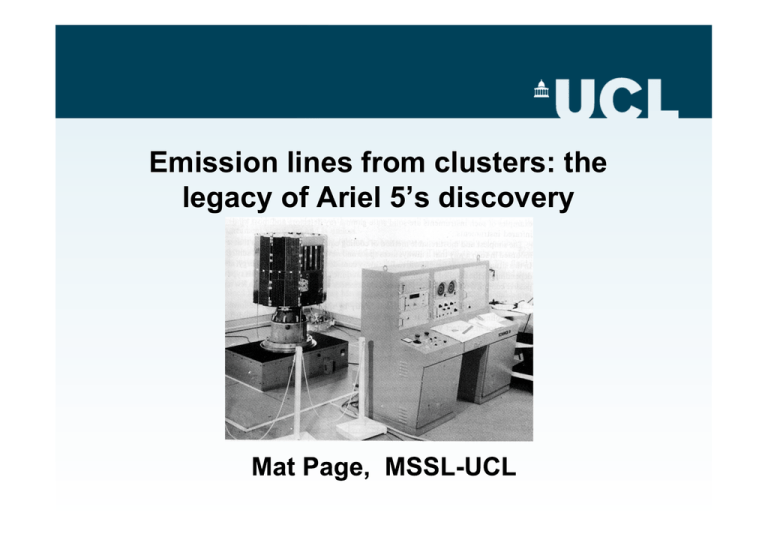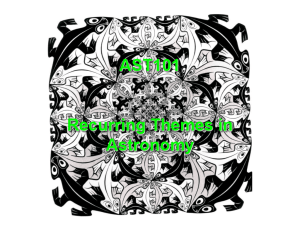Emission lines from clusters: the legacy of Ariel 5’s discovery
advertisement

Emission lines from clusters: the legacy of Ariel 5’s discovery Contents • Some personal thoughts on how important was the discovery of emission lines from clusters. – hopefully thought provoking – perhaps just provocative • Some of the science that has flowed down from this discovery. • I’m really the warm-up act for the two talks that follow. First, my own personal connection to Ariel 5 • About 20 years ago, the first paid job I had here at MSSL was transferring Ariel 5 and other data from old large-format (12 inch diameter) 800, 1600 and 6250 bpi tapes to dat casettes. • Then the old 12 inch tapes were thrown in a skip. • I might be the last person to have handled the original tapes of Ariel 5 experiment C data* (if those were the original tapes.. I’ve no idea if they were.) *if those were the original tapes; I don’t know whether they were. • A talk that took place in this room a year or two ago. • John Butterworth showed these plots that had come from CERN. • The discovery of the Higgs Boson. Nobel prize stuff. • These plots look rather like one that I use in my lectures. Perseus observed in 1975 • Remarkable visual similarity between this and the Higgs plots. • But it got me thinking about how the two results compare. If anyone was here from the particle physics group at UCL, they’d probably cut my head off for what I’m about to say. (I’m only joking) Higgs discovery is undeniably very exciting • New particle • Confirms a prediction that is decades old • Its discovery completes the family of particles that make up the standard model • It is essential for explaining mass in the standard model Higgs discovery is undeniably very exciting… but • As far as I understand, it confirms the current paradigm • i.e. nothing changes • The standard model of particle physics (indeed, quantum mechanics) as a theory is incomplete. There is as yet no quantum gravity. • The standard model only describes normal matter. It doesn’t describe (so far) dark matter let alone dark energy. Whatever dark matter is, it is still missing from the standard model of particle physics. • Normal matter is a tiny fraction of the energy density of today’s universe. Lets go back to the Ariel 5 discovery • Discovering the emission line meant that the Xray emission was thermal emission from hot gas. • There were several possibilities for the X-ray emission, so the discovery set the new paradigm. Clusters contain huge reservoirs of hot gas. • As we heard yesterday, it’s now thought that more than half of all baryonic matter today is in the form of hot* gas in clusters and filaments. • So arguably, this observation discovered more than half of the normal matter in the Universe. *Most of it probably isn’t as hot as in the massive clusters, but pretty hot nonetheless The hot gas doesn’t just tell us about normal matter • It is quite easily worked out that the hot gas wouldn’t stay put in clusters of galaxies if there wasn’t a huge quantity of dark matter holding it there. • The dark matter density profile can be worked out from the profile of the emitting gas. • The gas wasn’t the first evidence for dark matter, even in galaxy clusters, but it is a very important tool to understand it, as we’ve seen already yesterday. On to dark energy • Studies of the hot gas emission in clusters played an important part in understanding that the Universe’s gravitational attraction on large scales is dominated by cold dark matter (CDM) • Which was an essential step towards the current ΛCDM cosmological paradigm. • And the hot gas in clusters is still being used to test cosmology and refine cosmological parameters. • So the Ariel 5 discovery was an essential step in determining the contents, state and shape of our universe today. In other words • The Higgs is the final particle predicted in an incomplete theory that describes a tiny fraction of the mass/energy content of the Universe, and its discovery doesn’t change anything. • The 1975 observation with Ariel 5 set a new paradigm, effectively discovered more than half of the normal stuff in the Universe and was an essential step in determining the contents, state and shape of the Universe today. Even more extraordinary: • The Higgs boson was discovered by a team of thousands, from tens of nations, working over decades, with a particle accelerator the size of a small city, with a budget of billions. • Emission lines were discovered in clusters of galaxies by 4 UK scientists, working for a few months, using a few days of data, from a typewriter size instrument, that had been designed and put together in a few years, in an old house in England. (Sorry, I don’t know what the budget was). Let me leave the legacy for a minute to talk about the paper itself. • The first author, R J Mitchell was Len’s PhD student. • The paper’s not in Nature, but in Monthly Notices. • What a period of discovery this was: read the first line of the introduction! The paper itself. • Here’s the figure as presented in the paper. • Terrible data by today’s standard, but the paper is quite compelling. Now (seriously) to the legacy of the Ariel 5 discovery. • Scientifically, the legacy is huge. • Needless to say: – Every scientific paper about X-ray emission from clusters in the last 40 years has been written within the paradigm that clusters contain large reservoirs of hot gas. – The same for every paper about the Sunyaev Zeldovich effect in the submillimetre, whereby the microwave background spectrum is distorted when it passes through the hot gas. – And all the research which has used X-ray surveys of clusters for cosmology. – Our current understanding and expectations for the warm/hot intergalactic medium are rooted in this paradigm too. and • Our understanding of the radio jets and lobes of active galactic nuclei is also rooted in this paradigm. • The jets don’t propagate into a vacuum, but into the intracluster medium of hot gas. and • The X-ray emission lines themselves in clusters are used to study cosmic abundances as Jelle told us yesterday. • That’s telling us about the history of star formation, elemental production, supernovae in galaxies. • And because the emission lines in the cluster gas come from heavy elements that can’t be primordial, they tell us about gas that is leaving galaxies. Important aside now, to another paradigm-changing observation of X-ray emission lines in clusters. • RGS showed unambiguously that there was less cool material in clusters of galaxies than predicted by cooling flow models. • Something is stopping the gas from cooling. Peterson et al. 2003, ApJ, 590, 207 and • With AGN mechanical heating being the most plausible explanation for the lack of (relatively) cool gas, AGN “feedback” became a key component of models for galaxy formation. • So even the way galaxies are formed and how AGN affect that process is now rooted in the paradigm set by the Ariel 5 discovery. Bower et al. 2006, MNRAS, 370, 645 The legacy continued • If I’ve failed to convince you of the importance of the scientific legacy of the discovery itself, I’ve one final slide. • I don’t know how significantly the Ariel 5 discovery of emission lines influenced Len. Perhaps he’ll tell us. • But 6 years after Mitchell, Culhane, Ives & Davidson 1976, the following document was submitted to ESA.



